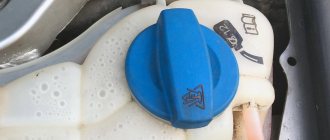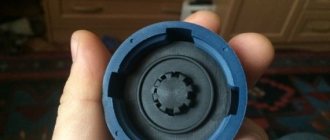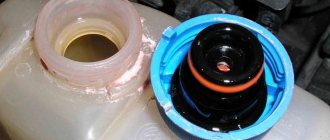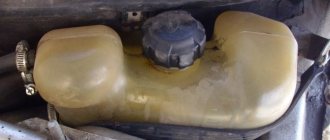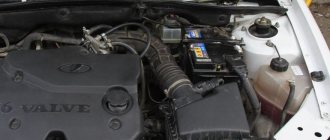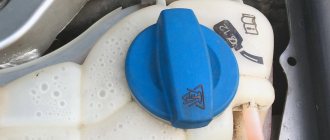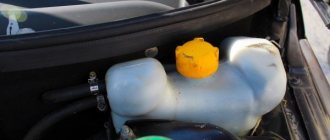Improving the cooling system of the practical domestic small car Lada Kalina can be done by modifying the cap on the expansion tank. Proper cooling of the motor during operation is the key to the durability of all its components. When the cap no longer serves its purpose correctly, the circuit loses efficiency due to pressure fluctuations. Many car owners are interested in how to check the expansion tank cap, as well as which cap is better.
Untimely release of excess pressure causes antifreeze leaks at the joints of rubber pipes with the outlets of units in Lada Kalina. All this leads to an increase in coolant temperature, and therefore the engine is at risk of overheating. In order to prevent negative consequences for the engine due to exposure to increased pressure, there is a designated tank, an important component of which is the cap.
After stopping the LADA Kalina engine, a gradual cooling of the system components is observed. Here the process is similar, but it happens in reverse. As the temperature decreases, air is sucked into the circuit.
It is recommended that the lid of the tank in question be periodically checked for the absence of scale and other deposits that impede the normal functioning of the valve, and which lid is better, everyone determines for themselves. Therefore, it is recommended to know how to check the expansion tank cap.
Tuesday, March 26, 2013
How to remove an airlock on Kalina
3. Failure of the cylinder head gasket (leakage from under the cylinder head, bubbling in the cylinder head, antifreeze in the oil crankcase - emulsion formation, abundant white steam in the exhaust). Low efficiency of the SOD, manifested in overheating, bubbling and poor heating of the interior, can be a consequence not only of a plug, but also a decrease in pump performance (breakage, deformation, rotation of the impeller on the shaft), kinks and contamination of the SOD. Incorrect operation of the thermostat (not fully opening) can also lead to difficulties when removing the plug. Only after thoroughly checking the ODS for the absence of these breakdowns should you start talking about the airlock and how to remove it. A traffic jam can form in a small or large circle. The plug is removed through the highest point of the system. Previously, in cars without an expansion tank, its functions were performed by the radiator. Therefore, there was a way to raise the front of the car so that the top of the radiator became the highest point and let the engine run. In our case, this is not very effective, because in a closed system, the plug can only exit into the expansion tank. There are no other places, but they can be created by disconnecting the system. Please note that the expansion tank in Kalina is included in a large circle, and without opening the thermostat, there is no way to remove the plug from the small circle in the Republic of Belarus. The coolant simply won't flow there. And now it’s clear why problems often arise in cold weather. It’s just that in cold weather the thermostat practically does not open, but completely, and therefore the release of the plug into the tank is very problematic. Now it becomes clear why gassing helps. It simply leads to faster heating and the opening of a large circle, which ensures the release of the plug, because the tank is installed in a large circle. But the car must be heated until the fan operates, i.e. up to 101-105 degrees, it is only at this temperature that the thermostat will fully open. That is. The condition for the plug to exit through the RB is the COMPLETE opening of the thermostat, and in winter, and even while driving, this is difficult to achieve. That's why she sits there tightly.
In order to remove the traffic jam
We must open the thermostat completely, for which we need to warm up the car until the fan comes on. To be sure, you can also squeeze the radiator inlet and outlet pipes. Is it necessary to lift your muzzle, the answer is no, rather you need to raise your left side, where the RB is located. Is it necessary to accelerate, most likely yes, but not with all the might, it’s just not realistic to warm up the car at idle in cold weather until the fan comes on. Those. the same effect can be obtained with a stationary car at medium speed. But keep in mind that this method can only help if the thermostat is in working order and opens completely (at least 8 mm opening), otherwise if it is not fully opened, if the plug is in a small circle and the coolant circulation is disrupted, by accelerating too much you can overheat the engine, with all the ensuing consequences. Please note that fanaticism in repairing SOD can end badly. Unfortunately, you can only check how the thermostat opens by removing it and boiling it in a pan of water. I would like to note that when filling coolant, it is better to always remove the pipe from the remote control, because Kalina's SOD is designed so that the system is filled from the bottom up. This way you are guaranteed not to get a traffic jam, but even here you should warm up the engine by turning on the fan, monitoring the coolant level in the coolant compartment and topping up if necessary. Stove. The stove is located relatively low and a plug can form there, which, provided there is a small difference in pressure at the inlet and outlet of the stove, is poorly expelled. Here it is better not to be lazy and if there is a problem, disconnect one hose going to the stove, pumping coolant through it. This will definitely eliminate any air that gets trapped there. Don’t feel sorry for spilled antifreeze when removing plugs in the SOD; this is a much smaller loss than what you can get.
What is the main role of the tank cap?
As is known, a running engine creates a pressure in the cooling system that differs from normal atmospheric pressure. This occurs due to the fact that the coolant heats up along with the engine, as a result of which it expands and increases in volume. As a result, the pressure inside the engine cooling system (ECS) increases, but it is not in contact with the external environment, and there is nowhere for it to relieve excess pressure.
Developers of modern cars do not fight the increased pressure in the ODS “radically” - they do not try to completely get rid of it. It is adjusted using the tank cap. Increased pressure in the SOD is used to shift the coolant boiling point. After all, it’s no secret that at normal atmospheric pressure for water it occurs at a temperature of 100 °C, for antifreeze – 105–110 °C, and for antifreeze – 120 °C. The operating temperature of modern car engines is very close to these critical values.
So, for example, for carburetor VAZs it should be in the range of 90–95 °C, and for injection ones – 97–105 °C.
However, under certain engine operating conditions, a short-term increase in its temperature occurs to higher values, which, however, does not lead to failure of a serviceable engine, but causes the same heating of the coolant. For example, on injection VAZ 2109 the liquid at such moments can be 120–125 °C. Obviously, even antifreeze cannot withstand such heat. At the same time, an increase in the pressure of any liquid leads to an increase in its boiling point.
Conclusion
The article turned out to be quite long and I hope informative.
As you can see, one cap does a huge job and always monitors the pressure in your cooling system, so it needs to be changed approximately every six months. Or at least have a spare cover that is known to work if the installed one suddenly fails.
The design and principle of operation of the expansion tank cap
In order for the necessary pressure to be created in the SOD when the engine is running, the lid device ensures a tight, hermetically sealed closure of the tank. A safety valve is provided to relieve excess pressure. It operates (opens) only when the pressure inside the SOD becomes 1.1–1.5 kgf/cm2 (depending on the design of the lid and its manufacturer).
While it is lower, the valve is closed, and immediately after releasing the excess pressure to a value that is less than that indicated above - partial release of the air compressed in the tank - it closes. There is one more valve in the lid - the inlet valve, it is also called a vacuum valve. Its purpose is exactly the opposite of protective. The inlet valve serves to intake (suction) air into the SOD. The fact is that after stopping the engine, as you know, it begins to cool down. The coolant temperature also drops.
Inlet valve cover
At the same time, it decreases in volume, which is accompanied by a decrease in pressure inside the SOD. The coolant that enters the tank, upon its own heating, begins to flow back into the system, freeing up space for the air remaining in the expansion tank and ceasing to put pressure on it. Then there comes a moment when the pressure in the SOD is compared with the external atmospheric pressure. If at the same time the temperature of the coolant turns out to be higher than in the external environment, then it, continuing to cool, will further decrease in volume.
This will lead to the pressure in the SOD becoming lower than atmospheric, that is, to a vacuum effect. The outside air will put pressure on the elements of the system and will tend to occupy its internal volume. If there is a “weak” place in any part of the SOD, where the tightness is broken when it cools and pressure exerted from outside, then air will enter the system and a so-called air lock may form in it. When the engine is started again, it can, of course, be pushed out by coolant into the expansion tank.
Auto coolant
But if this does not happen, the air lock will disrupt the circulation of fluid in the SOD, prevent the engine from cooling, and may even cause it to fail. Typically, air enters the system due to suction between the pipes and fittings on which they are mounted. To prevent this from happening, the pressure in the SOD is equalized with the external atmospheric inlet valve. It is triggered when there is a vacuum in the system of 0.03–0.1 kgf/cm 2 and admits air into the expansion tank, which actually replaces the coolant pushed out through the safety valve when heated. The internal pressure in the SOD is equalized with the external one.
Verification methods
Before checking the expansion tank plug, you need to know that car repair shops use special pressure pumps for this operation. They are configured in such a way as to bring the test to critical response values. Then it will be clear whether the opening or closing occurred at the right time.
Self-testing does not always provide objective evidence. However, when it is carried out, in most cases it is possible to identify the loss of unit functionality.
Performance monitoring is carried out as follows:
- With the engine cool, remove the cover and inspect it to identify chips, cracks or holes. All seals must be plastic and provide a tight seal. There should be no mechanical damage.
- Even if some minor damage is detected, we return everything to its place, tighten it tightly and start the engine.
- We wait for the internal combustion engine to warm up for several minutes and carefully begin to unscrew the cover along the threads. If you hear a small pop, similar to the sound of a drink bottle opening, you need to know that the pressure in the system is being contained.
- We carefully inspect the thick flexible hoses of the cooling system. If they are noticed to be pressed inward, then this is a sign that the valve is stimulating the formation of an unwanted vacuum inside the cavities.
Sometimes a test is performed to check that the minimum pressure has been eliminated. To do this, unscrew, remove the cover and squeeze one of the flexible thick hoses. Next, screw everything into place and only after that release the hose. If the valves are operational, the hose will return to its normal state, but otherwise, it will remain compressed.
Sometimes, after unscrewing, the valve remains inside the tank. This situation is not the norm, so it is necessary to look for a workable replacement for the product.
Signs and possible consequences of a part malfunction
Most often, the consequence of a malfunction of the cap is boiling of the coolant, sometimes accompanied by the ejection of the coolant from the expansion tank - a common occurrence for VAZ cars. If this happens at engine operating temperatures, then most likely the plug does not hold the required pressure.
Car coolant boiling
Another reason for the same phenomenon is that due to a malfunction of the vacuum valve, air entered the ODS and formed a plug, which disrupts normal circulation, and therefore the cooling of the coolant. In winter, due to an air lock, the stove may not work well. Unpleasant consequences: loss of coolant, which has to be topped up regularly. This happens when, due to increased pressure in the SOD, liquid is “expelled” through the joints between the fittings and pipes put on them, through clamps.
- rupture of low-quality pipes or those that have not been changed for a long time (a picture familiar not only to VAZ owners);
- the appearance of a leak in the main or heating radiator;
- tears the thermostat housing (for Nexia it’s a common thing - into 2 parts);
- burst expansion tank.
How to bleed air using the example of a range of vases
VAZ models have a design advantage in the arrangement of cooling system components - a convenient position of the cooled throttle assembly (carburetor), which is the highest place in the cooling system. The procedure for a Lada Kalina car is as follows (the only tool you need is a Phillips screwdriver).
Fully open the heater switch (to the highest temperature);
Remove the valve cover protective screen;
Disconnected heating outlet hose from the throttle fitting
Remove the cap from the expansion tank
How to check the cover and identify problems?
Before checking the expansion tank cap, it must first be inspected to make sure that it is intact and has no mechanical damage in the form of scratches, cracks and severe wear, and is also free of rust, dirt, scale and other defects. Then you should check the functionality of its valves. Several simple diagnostic methods that allow you to only approximately determine their serviceability are given below.
For safety valve. With the engine running and warm, loosen the cap. There should be a hissing sound of compressed air coming out of the tank. This means the valve holds pressure. But not every professional can determine which one exactly.
Unscrewing the tank cap
- If the SOD pipes look deformed (compressed, flat) before starting the engine for the first time in the morning, the valve is definitely faulty.
- Unscrew and remove the cover. Then we strongly squeeze one of the SOD pipes and, holding it like that, install and screw the plug back. Let go of the pipe. If it begins to take its original shape, the valve is most likely working.
A more reliable way to check the operation of the valves is to use a pump with a pressure gauge. You will also need any empty expansion tank. We connect to one of its fittings, and then fix with a clamp the pump hose, from which the tip for the nipple was previously removed. We plug the remaining outputs from the tank with some kind of plugs. Then close the tank with the lid being tested.
Pump with pressure gauge
You can also check it on the tank installed on your car without draining the coolant. To do this, for example, on a VAZ 2109, we disconnect from the expansion tank the pipe that comes from above and removes steam from the SOD. We install a pump hose instead. In order to plug it, we insert something of a round cross-section and suitable diameter, for example, a drill, into the disconnected pipe. Then we put a clamp on this hose and tighten it.
We turn on the pump and, watching the needle on its pressure gauge, record the moment a click appears, followed by a hissing sound coming out of the tank through the air plug. If this happened at around 1.1–1.5 kgf/cm2, and further pumping only leads to increased hissing, but the pressure does not increase, it means that the vacuum valve is not leaking, and the safety valve is working as expected.
A few tips for maintaining a healthy system
You can avoid most problems, from minor troubles to serious damage associated with the expansion tank cap, if you follow a few rules. Professionals advise the following:
- Change the expansion tank cap at least once every 2-3 years. Aggressive coolant components attack mechanism parts and seals, gradually destroying them.
- Use only the original cover to replace a worn one. Some analogues do not allow the engine to operate at the required temperatures.
- Check and adjust the valves only on a cold engine, otherwise you risk getting burned from boiling water splashing out under pressure.
- Use tuned expansion tank caps only temporarily. Such a part will not provide optimal engine performance parameters and is therefore poorly suited for installation on a car.
In most cases, to restore the functionality of the mechanism, it is enough to simply clean the valves and rubber seals from dirt and sediment. If this procedure does not help, then it is easier to buy a new one, since modern expansion tank caps are made non-removable.
Refinement of a new part - what to do if it does not function?
When it turns out that the lid stubbornly refuses to relieve excess pressure and/or is not able to restore air losses in the SOD, it can be modified. For some reason, the most complaints come from owners of VAZ, model 2109, including those who buy new plugs. It is clear that the reason for the incorrect operation of the cover valves lies in the too much rigidity of their springs.
To modify the cover, for example, for a VAZ 2109, it must first be disassembled. This must be done carefully, using pliers and a thin flat-blade screwdriver. We must try to remember where everything stood so that the springs do not fly away to God knows where. After the lid for the VAZ 2109 tank has been disassembled, it’s time for the wire cutters. They need to shorten the springs: the large one, for the safety valve, usually by 1 turn, and the small one by 2.
Shortening the plug spring
For the second, the length of the removed segment is not critical - as long as it generally supports the vacuum valve when it is closed and does not resist the external air pressure of 0.03–0.1 kgf/cm 2 . With a large spring it is more difficult - as if not to overdo it. You need to look at its rigidity and the pressure at which the safety valve opened when checking the tank cap of the VAZ 2109. After shortening the springs, we assemble the cap in the reverse order. Before use, it is advisable to check again how it works.
